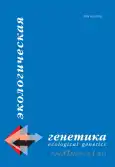Theoretical analysis of the predictability indices of the binary genetic tests
- Authors: Rubanovich A.V.1, Khromov-Borisov N.N.2
-
Affiliations:
- Vavilov Institute of General Genetics RAS
- Saint-Petersburg State I. P. Pavlov Medical University
- Issue: Vol 11, No 1 (2013)
- Pages: 77-90
- Section: Articles
- URL: https://journals.rcsi.science/ecolgenet/article/view/2398
- DOI: https://doi.org/10.17816/ecogen11177-90
- ID: 2398
Cite item
Full Text
Abstract
Full Text
##article.viewOnOriginalSite##About the authors
Aleksandr Vladimirovich Rubanovich
Vavilov Institute of General Genetics RAS
Email: rubanovich@vigg.ru
Head of Lab of ecological genetic
Nikita Nikolayevich Khromov-Borisov
Saint-Petersburg State I. P. Pavlov Medical University
Email: Nikita.KhromovBorisov@gmail.com
ssociate professor, Department of Physics, Mathematics and Informatics
References
- Aly M., Wiklun F., Xu J. et al., 2011. Polygenic risk score improves prostate cancer risk prediction: results from the Stockholm-1 cohort study // European Urology. Vol. 60. P. 21–28.
- Anonymous, 1996. How good is the test // Bandolier Journal. N 27. P. 2. http://www.medicine.ox.ac.uk/bandolier/painres/download/Bando027.pdf http://www.medicine.ox.ac.uk/bandolier/band27/b27–2.html.
- Banks E., Reeves G., Beral V. et. al., 2004. Influence of personal characteristics of individual women on sensitivity and specificity of mammography in the Million Women Study: cohort study // BMJ. Vol. 329. N. 7464. P. 477–479.
- Bjartell A., 2011. Genetic markers and the risk of developing prostate cancer // European Urology. Vol. 60. P. 29–31.
- Bossuyt P., 2010. Clinical validity: Defining biomarker performance // Scandinavian Journal of Clinical & Laboratory Investigation. 70. P. 46–52
- Cohen J., 1960. A coefficient of agreement for nominal scales // Educational and Psychological Measurement. Vol. 20. P. 37–46.
- Fawcett T., 2006. An introduction to ROC analysis //Pattern Recognition Letters. Vol. 27. P. 861–874.
- Folsom A., Cushman M., Tsai M. et al., 2002. A prospective study of venous thromboembolism in relation to factor V Leiden and related factors // Blood. Vol. 99. N. 9. P. 2720–2725.
- Ioannidis J., 2006. Commentary: Grading the credibility of molecular evidence for complex diseases //International Journal of Epidemiology. Vol. 35. P. 572–577.
- Jakobsdottir J., Gorin M. B., Conley Y. P. et al., 2009. Interpretation of genetic association studies: markers with replicated highly significant odds ratios may be poor classifiers // PLoS Genet. Vol. 5. N 2. e1000337.
- King G., Zeng L., 2002. Estimating risk and rate levels, ratios, and differences in case-control studies // Statistics in Medicine. Vol. 21. P. 1409–1427.
- Kraft P., Wacholder S., Cornelis M. C. et al., 2009. Beyond odds ratios — communicating disease risk based on genetic profiles // Nature Reviews Genetics. Vol. 10. P. 264–269.
- Kraemer H. C., Frank E., Kupfer D. J., 2011. How to assess the clinical impact of treatments on patients, rather than the statistical impact of treatments on measures // International Journal of Methods Psychiatric Research. Vol. 20. P. 63–72.
- Landis J. R., Koch G. G., 1977. The measurement of observer agreement for categorical data // Biometrics. Vol. 33. P. 159–174.
- Levin M. L., 1953. The occurrence of lung cancer in man // Acta Union International Contra Cancrum. Vol. 9. P. 531–541.
- Lewontin R. C., Kojima K., 1960. The evolutionary dynamics of complex polymorphisms // Evolution. Vol. 14. P. 458–472.
- Linn S., Grunau P. D., 2006. New patient-oriented summary measure of net total gain in certainty for dichotomous diagnostic tests // Epidemiologic Perspectives & Innovations. Vol. 3: 11. http://www.epi-perspectives.com/content/3/1/11.
- Mitchell A., 2009a. How To: Implement a Screening Programme for Distress in Cancer Settings // Psycho-oncology.info. — Guide # 101. http://www.psycho-oncology.info/PG_implement_ajmitchell.pdf.
- Mitchell A., 2009b. How To: Analyse a Screening or Diagnostic Study // Psycho-oncology.info. — Guide # 104. http://www.psycho-oncology.info/PG_analyse_ajmitchell.pdf.
- Pepe M. S., Gu J. W., Morris D. E., 2010. The potential of genes and other markers to inform about risk // Cancer Epidemiology, Biomarkers & Prevention. Vol. 19. P. 655–665.
- Poste G., 2011. Bring on the biomarkers // Nature. Vol. 469. P. 156–157.
- Sistrom C. L., Garvan C. W., 2004. Proportions, odds, and risk // Radiology. Vol. 230. P. 12–19.
- Slatkin M., 2008. Linkage disequilibrium — understanding the evolutionary past and mapping the medical future // Nature Reviews Genetics. Vol. 9. P. 477–485.
- Spielman R. S., McGinnis R. E., Ewens W. J., 1994. Letter to the Editor: The transmission/disequilibrium test detects cosegregation and linkage // American Journal of Human Genetics Vol. 54. P. 559–560.
- Swets J. A., 1988. Measuring the accuracy of diagnostic systems // Science. Vol. 240. P. 1285–1293.
- Tan P. N., Kumar V., Srivastava J., 2004. Selecting the right objective measure for association analysis //Information Systems. Vol. 29. P. 293–313.
- Winham S. J., Slater A. J., Motsinger-Reif A. A., 2010. A comparison of internal validation techniques for multifactor dimensionality reduction // BMC Bioinformatics. Vol. 11:394. http://www.biomedcentral.com/1471–2105/11/394
- Youden W. J., 1950. Index for rating diagnostic tests //Cancer. Vol. 3. P. 32–35.
- Yule G. U., 1912. On the methods of measuring association between two attributes // Journal of the Royal Statistical Society. Vol. 75. P. 579–652.
- Zhang J., Yu K. F., 1998. What’s the relative risk? A method of correcting the odds ratio in cohort studies of common outcomes // JAMA. Vol. 280. P. 1690–1691.
Supplementary files






